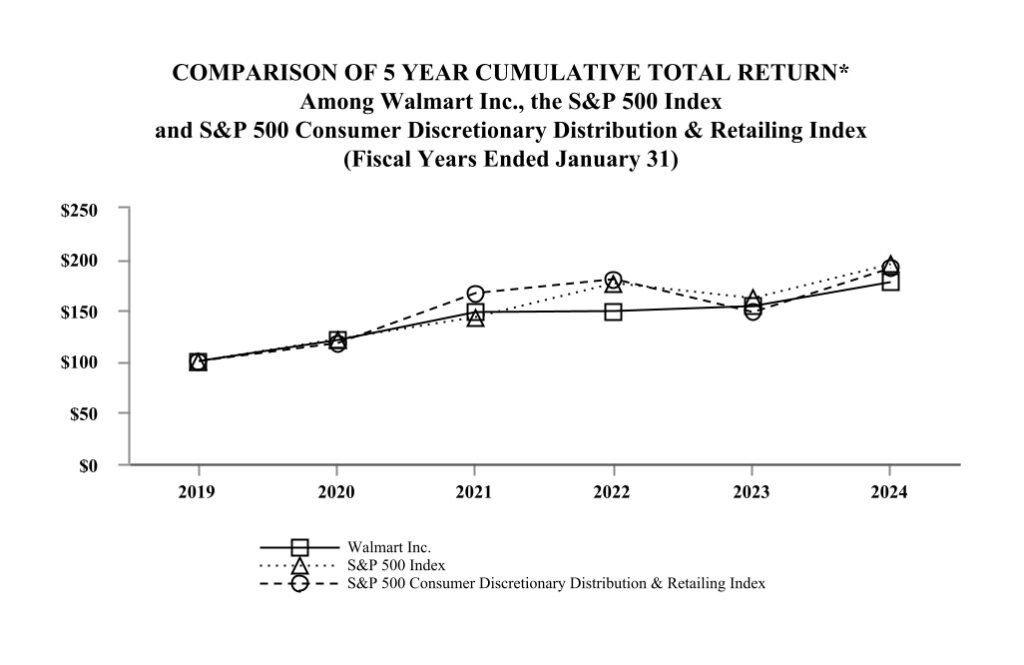
Asset condition analysis
The fiscal year 2024 ended January 31, 2024.
Walmart’ s total assets were $252.4 billion and $243.2 billion as of January 31, 2024 and January 31, 2023, respectively.
Property and equipment, net were $110.8 billion as of January 31, 2024, accounting for 43.9% of total assets.
Total current assets were $76.9 billion as of January 31, 2024.
Total current liabilities were $92.4 billion at January 31, 2024.
The current ratio was 0.83 times for fiscal 2024, which is terrible number, but may be an advantage against suppliers.
Days sales outstanding was 4.73 days for fiscal 2024.
Days sales of inventory was 41.5 days for fiscal 2024.
Days payable outstanding was 41.15 days for fiscal 2024.
The company ‘s cash conversion cycle was only about 5 days for fiscal 2024.
Walmart ‘s efficiency was very high to generate cash and the company had strong bargaining power against suppliers.
Total liabilities were about $162.1 billion as of January 31, 2024.
The debt ratio was 64% for fiscal 2024.
The balance sheet was very healthy.
Profitability analysis
Walmart’ s total revenues were $648.1 billion, $611.3 billion and $572.8 billion in fiscal 2024, 2023 and 2021, respectively.
The growth rate of total revenues was 6% and 6.7% in fiscal 2024 and 2023, respectively.
The growth rate is very slow, but the company’s P/E is very high.
Operating income was $27 billion, $20.4 billion and $26 billion in fiscal 2024, 2023 and 2022, respectively.
Operating profit margin was 4.2%, 3.3% and 4.5% in fiscal 2024, 2023 and 2022, respectively.
Consolidated net income was $16.27 billion, $11.3 billion and $14 billion in fiscal 2024, 2023 and 2022, respectively.
Total equity was $90.3 billion and $83.8 billion as of January 31, 2024 and January 31, 2023, respectively.
The rate of consolidated net income to total equity was 18% and 13.5% in fiscal 2024 and 2023, respectively.
Consolidated net income attributable to Walmart was $15.5 billion, $11.68 billion and $13.67 billion in fiscal 2024, 2023 and 2022, respectively.
Total Walmart shareholders’ equity was $83.86 billion and $76.7 billion in fiscal 2024 and 2023, respectively.
The rate of consolidated net income attributable to Walmart to total Walmart shareholders’ equity was 18.5% and 15.2% in fiscal 2024 and 2023, respectively.
Cash flow analysis
Net cash provided by operating activities was $35.7 billion, $28.8 billion and $24.2 billion in fiscal 2024, 2023 and 2022, respectively.
Payments for property and equipment were $20.6 billion, $16.9 billion and $13.1 billion in fiscal 2024, 2023 and 2022, respectively.
Free cash flow was $15.1 billion, $11.9 billion and $11.1 billion in fiscal 2024, 2023 and 2022, respectively.
Dividends paid were $6.14 billion, $6.11 billion and $6.15 billion in fiscal 2024, 2023 and 2021, respectively.
Purchases of stock were $2.78 billion, $10 billion and $9.8 billion in fiscal 2024, 2023 and 2022, respectively.
Conclusion
The balance sheet is very healthy, and Walmart’ s profitability is acceptable.
The company is not a growth one.
You should see the combined amount of dividends paid and purchases of stock as actual return.
We reckon that the company’s reasonable valuation is about $200 billion, though Walmart’ s market capitalization is $486 billion.
If you buy Walmart stock, your expected return should not be more than 10% each year.
Disclaimer: the content is for reference only and don’t constitute investment advice.
Introduction
Walmart Inc. (“Walmart,” the “Company” or “we”) is a people-led, technology-powered omni-channel retailer dedicated to helping people around the world save money and live better – anytime and anywhere – by providing the opportunity to shop in both retail stores and through eCommerce, and to access our other service offerings. Through innovation, we strive to continuously improve a customer-centric experience that seamlessly integrates our eCommerce and retail stores in an omni-channel offering that saves time for our customers. Each week, we serve approximately 255 million customers who visit more than 10,500 stores and numerous eCommerce websites in 19 countries.
Our strategy is to make every day easier for busy families, operate with discipline, sharpen our culture and become more digital, and make trust a competitive advantage. Making life easier for busy families includes our commitment to price leadership, which has been and will remain a cornerstone of our business, as well as increasing convenience to save our customers time. By leading on price, we earn the trust of our customers every day by providing a broad assortment of quality merchandise and services at everyday low prices (“EDLP”). EDLP is our pricing philosophy under which we price items at a low price every day so our customers trust that our prices will not change under frequent promotional activity. Everyday low cost (“EDLC”) is our commitment to control expenses so our cost savings can be passed along to our customers.
Our operations comprise three reportable segments: Walmart U.S., Walmart International and Sam’s Club. Our fiscal year ends on January 31 for our United States (“U.S.”) and Canadian operations. We consolidate all other operations generally using a one-month lag and on a calendar year basis. Our discussion is as of, and for the fiscal years ended, January 31, 2024 (“fiscal 2024”), January 31, 2023 (“fiscal 2023”) and January 31, 2022 (“fiscal 2022”). During fiscal 2024, we generated total revenues of $648.1 billion, which was comprised primarily of net sales of $642.6 billion.
We maintain our principal offices in Bentonville, Arkansas. Our common stock trades on the New York Stock Exchange under the symbol “WMT.”